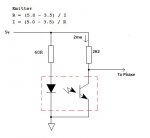buntay
Senior Member
Greetings fellow picaxers,
I request a little help on electrics.
What and why:
I need to count rpm’s and I am planning on using an LED with photocell or IR emitter and detector.
I have a disk with 2 holes that I will shine through one side and catch on the other. I am planning on using the count method for my capture method. With that being said here are my questions.
Looking at the sheets on what I am planning on using my IR emitter says forward voltage 1.5 , 1.8v max@ 50mA with a reverse voltage of 5v. My question is what is the schematic for powering it with 5v and does it stay on like a led or do I need to pulse it.
For the LED version the led says 3.5v max. What is the schematic for 5v.
Electronic design Is NOT my strong point and any help is greatly appreciated.
I request a little help on electrics.
What and why:
I need to count rpm’s and I am planning on using an LED with photocell or IR emitter and detector.
I have a disk with 2 holes that I will shine through one side and catch on the other. I am planning on using the count method for my capture method. With that being said here are my questions.
Looking at the sheets on what I am planning on using my IR emitter says forward voltage 1.5 , 1.8v max@ 50mA with a reverse voltage of 5v. My question is what is the schematic for powering it with 5v and does it stay on like a led or do I need to pulse it.
For the LED version the led says 3.5v max. What is the schematic for 5v.
Electronic design Is NOT my strong point and any help is greatly appreciated.


